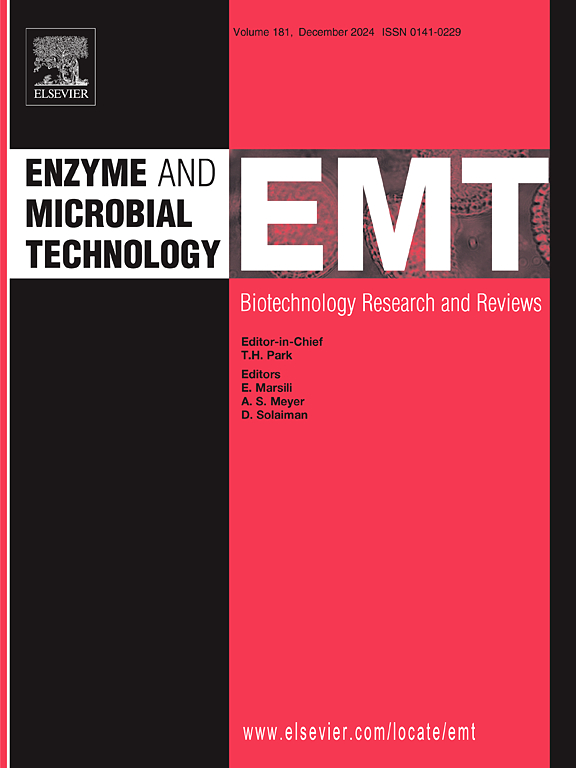Enhanced production of hyperthermophilic Pyrococcus furiosus β-glucosidase in Corynebacterium glutamicum by optimization of the promoter, vector backbone, and His-tag location
IF 3.7
3区 生物学
Q2 BIOTECHNOLOGY & APPLIED MICROBIOLOGY
引用次数: 0
Abstract
A hyperthermophilic β-glucosidase from Pyrococcus furiosus (PfBGL) is a highly stable and active glycoside hydrolase, well-suited for a wide range of applications. Although PfBGL has been successfully expressed in Escherichia coli, the use of this host limits its applicability in the healthcare and food processing industries due to safety concerns associated with E. coli-based expression systems. Recently, Corynebacterium glutamicum has emerged as a safe and versatile microbial platform for the expression of recombinant proteins used in food processing, pharmaceutical development, therapeutic enzyme production, and probiotic applications. Despite these advantages, heterologous expression in C. glutamicum is often hindered by low protein yields, and PfBGL expression in this host has not been previously explored. In this study, we report for the first time the production of PfBGL in C. glutamicum, achieving a 15-fold enhancement through the optimization of the promoter, the vector backbone, and the His-tag location. Among four different promoters, the Ptrc promoter with RBST7 yielded the highest PfBGL expression. For the Ptrc-RBST7 combination, the PfBGL expression levels further varied depending on the vector backbone. Interestingly, placing the His-tag at the N-terminus of PfBGL not only increased its expression in C. glutamicum, but also enhanced its enzymatic activity (kcat/Km), when compared to C-terminal tagging. Overall, this study showcases a simple yet effective strategy at both genetic and protein levels to enhance PfBGL production in C. glutamicum, thereby broadening its utility as a host for diverse protein production applications.
通过优化启动子、载体骨架和his -标签位置,提高了谷氨酸棒状杆菌中嗜热热焦球菌β-葡萄糖苷酶的产生
一种来自炽热焦球菌(Pyrococcus furiosus, PfBGL)的超嗜热β-葡萄糖苷酶(hyperthermoophilic β-glucosidase, PfBGL)是一种高度稳定和活跃的糖苷水解酶,具有广泛的应用前景。虽然PfBGL已在大肠杆菌中成功表达,但由于与大肠杆菌表达系统相关的安全问题,该宿主的使用限制了其在医疗保健和食品加工行业的适用性。最近,谷氨酰胺棒状杆菌作为一种安全、通用的微生物平台,在食品加工、药物开发、治疗酶生产和益生菌应用中表达重组蛋白。尽管具有这些优势,但谷氨酰胺C. glutamum的异源表达经常受到低蛋白产量的阻碍,并且PfBGL在该宿主中的表达先前尚未探索过。在这项研究中,我们首次报道了C. glutamicum中PfBGL的产生,通过优化启动子、载体骨架和his标签的位置,实现了15倍的增强。在4个不同的启动子中,含RBST7的Ptrc启动子的PfBGL表达量最高。对于Ptrc-RBST7组合,PfBGL的表达水平随着载体主干的不同而进一步变化。有趣的是,与c端标记相比,在PfBGL的n端放置his标签不仅增加了PfBGL在C. glutamicum中的表达,而且提高了PfBGL的酶活性(kcat/Km)。总的来说,本研究展示了一种简单而有效的策略,可以在遗传和蛋白质水平上提高谷氨酸酵母PfBGL的产量,从而扩大其作为宿主在多种蛋白质生产应用中的效用。
本文章由计算机程序翻译,如有差异,请以英文原文为准。
求助全文
约1分钟内获得全文
求助全文
来源期刊

Enzyme and Microbial Technology
生物-生物工程与应用微生物
CiteScore
7.60
自引率
5.90%
发文量
142
审稿时长
38 days
期刊介绍:
Enzyme and Microbial Technology is an international, peer-reviewed journal publishing original research and reviews, of biotechnological significance and novelty, on basic and applied aspects of the science and technology of processes involving the use of enzymes, micro-organisms, animal cells and plant cells.
We especially encourage submissions on:
Biocatalysis and the use of Directed Evolution in Synthetic Biology and Biotechnology
Biotechnological Production of New Bioactive Molecules, Biomaterials, Biopharmaceuticals, and Biofuels
New Imaging Techniques and Biosensors, especially as applicable to Healthcare and Systems Biology
New Biotechnological Approaches in Genomics, Proteomics and Metabolomics
Metabolic Engineering, Biomolecular Engineering and Nanobiotechnology
Manuscripts which report isolation, purification, immobilization or utilization of organisms or enzymes which are already well-described in the literature are not suitable for publication in EMT, unless their primary purpose is to report significant new findings or approaches which are of broad biotechnological importance. Similarly, manuscripts which report optimization studies on well-established processes are inappropriate. EMT does not accept papers dealing with mathematical modeling unless they report significant, new experimental data.
 求助内容:
求助内容: 应助结果提醒方式:
应助结果提醒方式:


